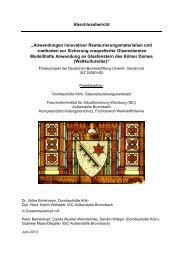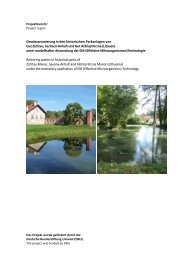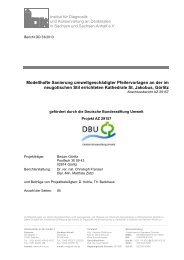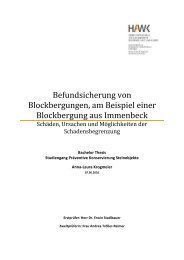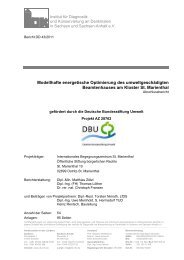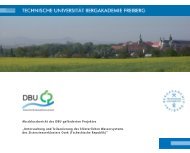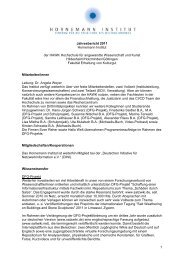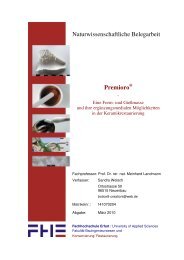Download PDF
Download PDF
Download PDF
Sie wollen auch ein ePaper? Erhöhen Sie die Reichweite Ihrer Titel.
YUMPU macht aus Druck-PDFs automatisch weboptimierte ePaper, die Google liebt.
Weichmacherverlust bei PVC-Objekten von Joseph Beuys – Versuche zu kurativen und konservatorischen Massnahmen<br />
ANHANG III: ZUSAMMENSTELLUNG VON ABSTRACTS<br />
Zahran, A. H.; Nofal, E.; Elsabee, M. Z.; El-Azmirly, M. A. (1979): Irradiation of poly(vinyl chloride) with H2<br />
plasma. In: Journal of Applied Polymer Science, Volume 24, Issue 7, Date: 1 October 1979, S. 1723-1737<br />
A system has been designed to serve as a plasma source and has the advantage of producing plasma of known<br />
energy and controlled intensity. Poly(vinyl chloride) films were irradiated with hydrogen plasma for different intervals of<br />
time. The effect of irradiation time and storing on the extent of crosslinking was investigated. The viscosity of the<br />
soluble part decreased at the initial stage of irradiation, then increased. The crosslinking extent was observed by<br />
measuring the swelling ratio of the irradiated samples. Spectral analysis indicated the formation of carbonyl groups<br />
and polyene structure in the irradiated PVC. The mechanisms of dehydrochlorination and crosslinking are discussed.<br />
Balazs, D. J.; Triandafillu, K.; Chevolot, Y.; Aronsson, B.-O.; Harms, H.; Descouts, P.; Mathieu, H. J. (1979):<br />
Surface modification of PVC endotracheal tubes by oxygen glow discharge to reduce bacterial<br />
adhesion. In: Surface and Interface Analysis, 1979, Volume 35, Issue 3 , S. 301 - 309<br />
A d.c. oxygen glow discharge was used to modify medical-grade PVC to study how surface chemistry and<br />
hydrophilicity influence Pseudomonas aeruginosa adhesion. The effects of plasma exposure time on the resulting<br />
surface, including chemical composition, wettability and roughness, were assessed using x-ray photoelectron<br />
spectroscopy, contact angle measurements and atomic force microscopy analysis. A significant alteration in the<br />
hydrophilicity of the native PVC surface was observed after oxygen glow discharge treatment. The water contact<br />
angle decreased from 80° to 8-20°, with a weak dependence of the exposure time used. The change in surface<br />
wettability resulted from the incorporation of oxygenated functional groups, including esters, ketones and acids, as<br />
indicated by XPS analysis. The amount of oxygen incorporation was shown to be essentially independent of plasma<br />
exposure time. However, prolonged plasma exposure resulted in increased surface roughness. Bacterial adhesion<br />
efficiency was evaluated for PVC modified by 120 s of plasma exposure, because this exposure time was determined<br />
to yield the maximum decrease in contact angle. Oxygen plasma treatment of native PVC was found to yield a 70%<br />
reduction in bacterial adhesion for the four strains of Pseudomonas aeruginosa tested.




